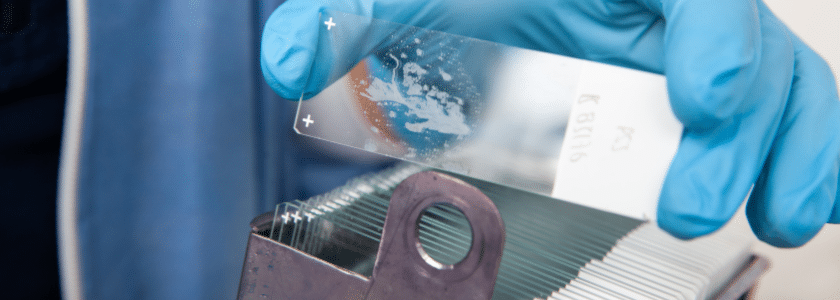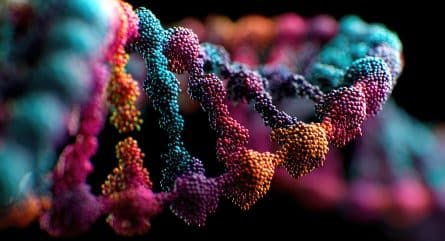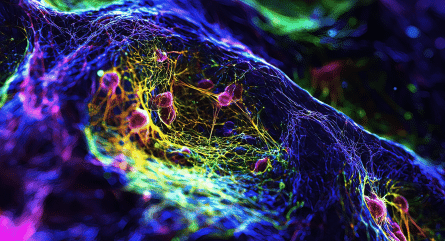The Takeaway: Formalin-fixed paraffin-embedded (FFPE) tissues are a key resource in the pathology and medical research fields, and they are now the leading way to preserve tissue samples for future analysis. Do you want to learn more about FFPE? This article provides answers to some of the most common questions about FFPE and its use in the genetics field.
What is FFPE?
FFPE stands for formalin-fixed paraffin-embedded. It is a method that is used to preserve tissue samples for future analysis, including examinations, experimental research, and diagnostic development.
How is FFPE prepared?
The process of preparing FFPE involves several steps:
- Fixation: The tissue is immersed in formalin, a formaldehyde solution that links proteins and nucleic acids in a way that can preserve cellular structure.
- Dehydration: The tissue is dehydrated by immersing it in a series of ethanol solutions of increasing concentration.
- Clearing: Tissue samples are then placed in xylene. This removes the ethanol and renders the tissue transparent.
- Infiltration: The tissue is infiltrated with molten paraffin wax. This wax solidifies and embeds the tissue for long-term preservation.
- Sectioning: The FFPE block is cut into thin sections (usually 4-5 micrometers thick) for analysis.
What are the advantages of FFPE tissue preservation?
FFPE tissues offer several advantages that make it an essential resource in various fields:
- Long-term preservation: FFPE samples can be stored for decades without degrading significantly. This allows researchers to go back to the samples in the future and analyze them.
- Preservation of cellular structure: FFPE maintains cellular structure, which makes it possible to examine tissues at a microscopic level.
- Compatibility with a wide range of tests: FFPE samples can be used for several laboratory techniques, including histopathology, immunohistochemistry, and molecular analysis like DNA, RNA, and protein extraction.
- Clinical relevance: FFPE samples are often derived from patient tissues, providing valuable insights into disease mechanisms and treatment responses.
What are some common applications of FFPE tissues?
FFPE tissues are used in a wide range of applications, including:
- Histopathology: This involves the microscopic examination of tissue sections to diagnose diseases, assess tumor margins, and evaluate the effects of treatment.
- Immunohistochemistry (IHC): IHC uses antibodies to detect specific proteins in FFPE tissue sections, providing insights into the molecular makeup of the tissue.
- Molecular analysis: FFPE tissues can be used for DNA, RNA, and protein extraction, allowing researchers to study genetic mutations, gene expression, and protein levels.
- Archival storage: FFPE samples serve as a valuable resource for long-term storage, enabling future research on diseases, therapies, and patient outcomes.
Can FFPE tissues be used for genetic studies?
Yes, FFPE tissues are used frequently in genetic studies. While formalin fixation can cause DNA fragmentation and modifications, advancements in DNA extraction techniques and molecular biology have made it possible to obtain high-quality DNA from FFPE tissues. Researchers use FFPE samples to study genetic mutations, copy number variations, and other genetic alterations associated with diseases like cancer.
Can FFPE tissues be used for RNA analysis?
Yes, FFPE tissues can also be used for RNA analysis. While RNA is more sensitive to degrading through formalin fixation than DNA, modern RNA extraction methods and quality control techniques have made it feasible to analyze gene expression and perform transcriptome studies using FFPE tissues. This is particularly valuable for understanding the molecular basis of diseases and identifying potential therapeutic targets.
What challenges are associated with FFPE tissues?
Despite their many advantages, FFPE tissues come with some challenges, including:
- Fixation-induced damage: Formalin fixation can cause cross-linking of proteins and nucleic acids, leading to DNA and RNA fragmentation and modifications.
- Degradation over time: While FFPE tissues can be stored for extended periods, the quality of nucleic acids and proteins can degrade over time, affecting the results of molecular analyses.
- Inconsistent fixation: The quality of FFPE samples may vary depending on the fixation process and storage conditions, making it essential to standardize procedures.
- Recovery of nucleic acids: Recovering high-quality DNA and RNA from FFPE tissues can be challenging, requiring specialized extraction methods.
How can the challenges of FFPE tissue analysis be addressed?
To address the challenges associated with FFPE tissues, researchers and clinicians can do a number of things:
- Standardization: Standardizing the fixation and storage procedures can help minimize variability in FFPE sample quality.
- Quality control: Implementing quality control measures to assess the integrity of nucleic acids and proteins before analysis is crucial.
- Optimized extraction methods: Utilize specialized extraction methods designed for FFPE tissues to recover high-quality DNA and RNA.
- Use of fresh-frozen tissues: In some cases, fresh-frozen tissues may be a better option for molecular analysis, as they can yield higher-quality nucleic acids and proteins.
Can FFPE tissues be used for retrospective studies?
Yes, FFPE tissues are ideal for retrospective studies. These samples are often derived from archived clinical specimens, making them valuable for studying diseases and treatment responses over time. Researchers can analyze FFPE tissues collected from different time points, enabling longitudinal studies and assessments of disease progression.
Are there limitations to using FFPE tissues in research?
While FFPE tissues offer numerous advantages, they also have limitations:
- Quality degradation: As mentioned earlier, nucleic acids and proteins in FFPE tissues can degrade over time, potentially affecting the results of molecular analyses.
- Tissue heterogeneity: The sectioning process may not capture the entire tissue, leading to potential heterogeneity in the analysis results.
- Cross-linking artifacts: Formalin fixation can create artifacts, affecting the interpretation of histopathology and molecular results.
- Despite these limitations, careful handling, standardized procedures, and quality control can help mitigate these issues.
Can FFPE tissues be used in drug development and personalized medicine?
Yes, FFPE tissues play a crucial role in drug development and personalized medicine. Researchers can use FFPE samples to identify potential drug targets, study drug responses in patient tissues, and develop therapies tailored to individual patients. The ability to analyze archived FFPE tissues from clinical trials and patient populations is invaluable in advancing precision medicine.
Where does IDT fit in?
IDT’s xGen™ cfDNA and FFPE DNA Library Preparation Kit permits high library complexity from low-quality samples. This solution features an automation-friendly four-hour workflow that only includes four major steps and is suitable for many research applications that use degraded samples, including low-frequency somatic variant ID of SNPs, insertions and deletions, identification of inherited germline SNPs and indels, and whole genome sequencing.
To learn more, request a consultation.


























